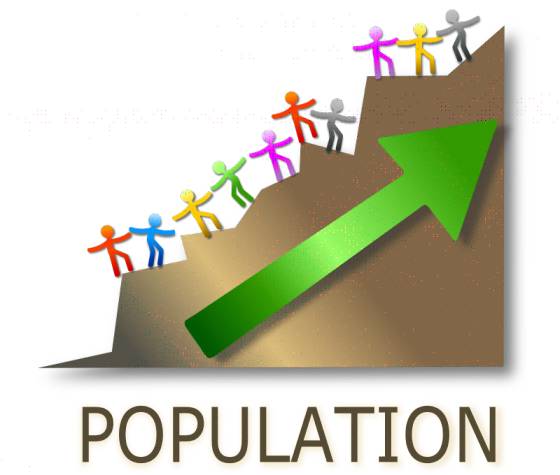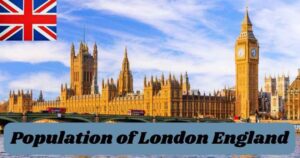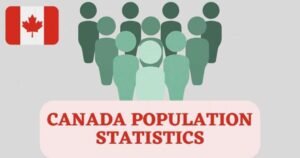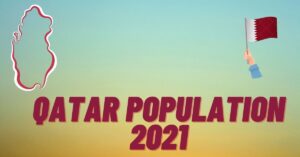The population of the United States has been steadily growing since the country’s founding. No other country in the world has as diverse of a population as the United States of America, which has more than 332 million people living in it across 50 states. If you’re curious about the history of this massive population, how it has changed over time, and what this means for future growth, keep reading to learn everything you need to know about the population of the United States!
Current Population of US
What is the current population of the United States in 2024?
According to the data provided by U.S. Census Bureau, the current Population of US in 2024 is estimated to be 333,044,954.
According to United Nations, Population of US in 2024 is estimated to be 334.805 million, with a growth rate of 0.57%. The Male population in US is 165.658 million and Female population is 169.147 million. The birth rate is 12 births/1000 population and the death rate is 8.7 deaths/1000 population.

US Population Statistics 2024
The United States has the third-largest population in the world behind China and India, but it’s still pretty large numbers spread across 50 states and Washington, D.C.
There were many figures from different source for the current population of US in 2024. The data was researched from a host of different institutions, who had used their own methodologies to arrive at their figures.
The present US population figures are listed from different websites in the below table.
| SOURCES | CURRENT POPULATION OF US | YEAR |
|---|---|---|
| U.S. Census Bureau | 333,044,954 (333.0 m) | 2024 |
| United Nations | 338,290,000 (338.2 m) | 2024 |
| Countrymeters.info | 336,711,391 (336.7 m) | 2024 |
| Worldometers.info | 335,249,498 (335.2 m) | 2024 |
| Statista.com | 333,390,000 (333.3 m) | 2024 |
| Worldpopulationreview.com | 338,343,549 (338.3 m) | 2024 |
| Populationpyramid.net | 334,805,268 (334.8 m) | 2024 |
Male and Female Population in US 2024
| MALE | FEMALE |
|---|---|
| 51.95% | 48.05% |
| 165,658,000 | 169,147,000 |
In 2024, females make up 50.52% of the population at 169.147 million, while the number of males accounts for 49.48% of the total population at 165.658 million. That makes the gender split at 49% male – 51% female.
Age-wise Population of US in 2024
| AGE GROUP | POPULATION | PERCENTAGE |
|---|---|---|
| 0-14 years | 60,604,372 | 18.10% |
| 15-24 years | 43,525,942 | 13.00% |
| 25-34 years | 47,313,219 | 14.31% |
| 35-44 years | 43,013,609 | 12.84% |
| 45-54 years | 40,083,513 | 11.97% |
| 55-64 years | 41,857,030 | 12.50% |
| 65 years and over | 58,407,582 | 17.44% |
58.03% of the US population is below the age of 44. The majority of the Americans falls in the age group of 0 to 14 years. This accounts for a staggering 60 million. This is closely followed by the 65+ age group, which numbers 58.4 million. A large part (17.44%) of this can be attributed to the population of older men and women who fall in this age category.
History about the US population
Total Population of US from 1990 according to United Nations Data
| Year | US Population (in million) |
|---|---|
| 1990 | 248.08 |
| 1991 | 251.56 |
| 1992 | 255.18 |
| 1993 | 258.78 |
| 1994 | 262.27 |
| 1995 | 265.66 |
| 1996 | 268.98 |
| 1997 | 272.40 |
| 1998 | 275.84 |
| 1999 | 279.18 |
| 2000 | 282.40 |
| 2001 | 285.47 |
| 2002 | 288.35 |
| 2003 | 291.11 |
| 2004 | 293.95 |
| 2005 | 296.84 |
| 2006 | 299.75 |
| 2007 | 302.74 |
| 2008 | 305.69 |
| 2009 | 308.51 |
| 2010 | 311.18 |
| 2011 | 313.88 |
| 2012 | 316.65 |
| 2013 | 319.38 |
| 2014 | 322.03 |
| 2015 | 324.61 |
| 2016 | 327.21 |
| 2017 | 329.79 |
| 2018 | 332.14 |
| 2019 | 334.32 |
| 2020 | 335.94 |
| 2021 | 337.00 |
| 2022 | 338.29 |
The population of the United States has been steadily increasing since 1790, when the first census was conducted by the U.S. government. In 1800, shortly after declaring independence from Great Britain, only a quarter million people inhabited what is now known as the US. By 1900 that number had ballooned to 76 million. It was not until after World War II that population growth in America took off like a rocket. By 1950 our country’s population exceeded 150 million. From there it has continued growing at an average rate of about 1% every year until today, when we are well over 338 million. That’s a lot of people!
What will happen next? How many Americans will there be in 2060? And how will they live? To answer these questions, let’s look at some population projections for the USA. We can see by looking at data from past decades that even though population growth tends to slow down as countries get richer and their populations become more educated, population projections still tend to err on the side of high numbers. The census in 2010 estimated that there were 309,591,917 people living in the United States at that time.
There are almost 324 million people living in the United States as of 2015, making it the third most populous country in the world after China and India. It has taken hundreds of years to get to this point, but the population has exploded since the country was founded in 1776, going from just a few thousand settlers to millions of residents who live throughout the 50 states and their territories. The population change over that time has been notable, so let’s take a look at how America grew from a few thousand people to almost 334 million today!
As of 2016, the population of the United States sits at an estimated 325 million. This number includes about 13 million foreign-born residents and 16 million undocumented immigrants who are not officially part of that count. The population growth rate from 2010 to 2017 was 0.7% per year, but between 2017 and 2060 it’s projected to fall to 0.4%.
The Census Bureau projects that growth will continue, with Texas surpassing New York in population. This growth is largely driven by natural increase—more births than deaths—as well as international migration. Future population growth will be slow and steady, increasing slowly from what is now more than 334 million people to around 350 million people by 2050. From there, total population could eventually increase further, depending on future levels of immigration. Currently, about one-in-five US residents are foreign born; for comparison purposes, you can think of that as similar to a large city like London or Paris. By 2060, nearly one-in-four Americans could be foreign born—similar to a place like Hong Kong today.
Total Population Projections
The U.S. population is projected to be near 420 million in 2042 (up from 315 million in 2017). But population growth varies by region. For example, some states are expected to grow rapidly because of migration, while others will have slower-than-average growth or even decline as a result of domestic migration patterns and/or natural decrease (more deaths than births). By 2060, we estimate that about 43% of states will have more people due primarily to natural increase and not including international migration. The fastest growing states over that period—the ones experiencing more than 100% population growth—will be Nevada, Idaho, Utah, Texas and Florida.
Overall birth rates in those five states were at least 50% higher than those in any other state in 2016. In contrast, North Dakota’s population declined 2.2% between 2015 and 2016—the largest percentage drop among all states during that time period. The population also fell slightly in West Virginia (0.3%) and Wyoming (0.4%). Between 2020 and 2030, nine states are projected to lose population: Alaska, Connecticut, Illinois, Maine, Mississippi, New Mexico, Pennsylvania, Vermont and Wyoming. In addition to declines caused by domestic migration losses or low fertility rates (which occur when women bear fewer children), these eight declining states are also affected by an aging population with relatively low levels of immigration from abroad or within their borders.
Overpopulation in the US
Most experts agree that overpopulation is a serious issue in some parts of Africa, Asia, and South America. Although we don’t often think about it, overpopulation is a real problem in the US. There are currently 334 million people living in America. It’s projected that by 2032, there will be more than 400 million people living here—and those projections might be overly optimistic! When you consider where most Americans live (urban areas), it’s easy to see how overcrowding becomes an issue. Cities get really congested because there are so many people packed into tight spaces. Plus, when there are too many people crammed together in one place, it can lead to all sorts of problems—like crime and disease.
The good news is that while our population continues to grow at a rapid pace, our overall fertility rate has been declining for decades. This means that we’re having fewer children on average than previous generations did. As fertility rates continue to decline across all racial groups, our population growth should eventually level off or even start shrinking. Even though our population is growing rapidly now, hopefully it won’t be long before things stabilize!
Components of Population Change
Population change is driven by two main components—natural increase and net migration. Natural increase accounts for births minus deaths. Net migration, or net international migration, encompasses both immigration and emigration (the movement of people out of a country). These numbers can fluctuate year-to-year, but a good rule is that as long as there are more births than deaths—more additions than subtractions—population will grow. Births, deaths, and immigration are known as components of population change. In 2016, there were a total of 1.2 million births in us and more than 2.6 million deaths. The difference between these two figures yielded an annual natural increase (births minus deaths) of around 540,000 people that year.
International Migration
The most recent estimates from July 2015 put the U.S. population at 318.9 million, up about 1% from July 2014 and 3.2% over July 2010 (the 2010 Census). The country’s population has increased by more than a third since 1990 when it was approximately 248 million. The U.S. is expected to grow even larger by 2050 when it is projected to reach 415 million, according to the Census Bureau’s National Population Projections: 2015-2050 report released in December 2014. This projection suggests that if current trends continue, another 100 million people will be added in 40 years—for a total population approaching 440 million people (see graph below). The main reason for such growth? More births than deaths and immigration from other countries.
The population projections are based on three assumptions: life expectancy at birth remains constant; net international migration remains constant; and net illegal immigration becomes zero after 2008. The middle series assumes an average annual population increase of 0.7%, while the high series assumes an average annual increase of 1%. According to these projections, between 2015 and 2025 natural increase (births minus deaths) will account for just under half of overall population growth, with 49% coming from net international migration and 2% from net illegal immigration. In 2035, natural increase accounts for just over one-third of overall population growth, with 54% coming from net international migration and 4% from net illegal immigration.
(Source: U.S. Census Bureau, United Nations, populationpyramid.net)
READ: INDIA POPULATION STATISTICS
Disclaimer: The data research report we present here is based on information found from various sources. We are not liable for any financial loss, errors, or damages of any kind that may result from the use of the information herein. We acknowledge that though we try to report accurately, we cannot verify the absolute facts of everything that has been represented.








